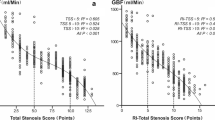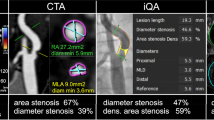Abstract
Purpose
The pulsatility index (PI) obtained from carotid ultrasonography is considered to be a marker of cerebrovascular resistance. However, the impact of PI on cardiovascular events has yet to be fully addressed.
Method
Fifty-four patients who underwent both carotid ultrasonography and coronary angiography were followed for 5.9 ± 3.2 years. The relationship between the incidence of cardiovascular events and PI was investigated.
Result
There were 10 (19%) deaths, four (7%) cardiovascular deaths, and nine (17%) major adverse cardiovascular events (MACEs). The cardiovascular events—defined as all hospitalization for MACEs plus heart failure, revascularization, and cardiovascular surgery—occurred in 21 patients (39%). The patients were divided into two groups according to each threshold of PI value for common carotid arteries (CCA), internal carotid arteries (ICA), and external carotid arteries (ECA), respectively. The thresholds were calculated based on receiver-operating characteristic curves for cardiovascular events. Log-rank test showed that the groups with CCA-PI ≥ 1.71, ICA-PI ≥ 1.20, and ECA-PI ≥ 2.46 had a higher incidence of cardiovascular events, respectively (p < 0.05). ECA-PI ≥ 2.46 was associated with an increased incidence of MACEs. Multivariate Cox regression analysis adjusting for cardiovascular risk factors showed that high PI of CCA, ICA, or ECA was a risk factor for cardiovascular events, respectively (CCA-PI ≥ 1.71, hazard ratio (HR) 3.242, p = 0.042; ICA-PI ≥ 1.20, HR 3.639, p = 0.012; ECA-PI ≥ 2.46, HR 11.322, p = 0.001).
Conclusion
The results suggested that carotid PIs were independent predictive factors for further cardiovascular events. In particular, high ECA-PI levels may reflect severe arteriosclerosis.

Similar content being viewed by others
Data availability
This manuscript reports the results of clinical trials. The data will not be shared.
References
Parish S, Arnold M, Clarke R, et al. Assessment of the role of carotid atherosclerosis in the association between major cardiovascular risk factors and ischemic stroke subtypes. JAMA Netw Open. 2019;2:e194873.
Touboul PJ, Hennerici MG, Meairs S, et al. Mannheim carotid intima-media thickness and plaque consensus (2004-2006-2011). An update on behalf of the advisory board of the 3rd, 4th and 5th watching the risk symposia, at the 13th, 15th and 20th European Stroke Conferences, Mannheim, Germany, 2004, Brussels, Belgium, 2006, and Hamburg, Germany, 2011. Cerebrovasc Dis. 2012;34:290–6.
Wu Y, He J, Sun X, et al. Carotid atherosclerosis and its relationship to coronary heart disease and stroke risk in patients with type 2 diabetes mellitus. Medicine. 2017;96:e8151.
Mortimer R, Nachiappan S, Howlett DC. Carotid artery stenosis screening: where are we now? Br J Radiol. 2018;91:20170380.
Chuang SY, Cheng HM, Bai CH, et al. Blood pressure, carotid flow pulsatility, and the risk of stroke; a community-based study. Stroke. 2016;47:2262–8.
Kitaoka M, Terminology and Diagnostic Criteria Committee, Japan Society of Ultrasonics in Medicine. Standard method for ultrasound evaluation of carotid artery lesions. J Med Ultrason. 2009;36:219–26.
Lee KY, Sohn YH, Baik JS. Arterial pulsatility as an index of cerebral microangiopathy in diabetes. Stroke. 2000;31:1111–5.
Tanaka T, Shimizu T, Fukuhara T. The relationship between leukoaraiosis volume and parameters of carotid artery duplex ultrasonographic scanning in asymptomatic diabetic patients. Comput Med Imaging Graph. 2009;33:489–93.
Webb AJ, Simoni M, Mazzucco S, et al. Increased cerebral arterial pulsatility in patients with leukoaraiosis: arterial stiffness enhances transmission of aortic pulsatility. Stroke. 2012;43:2631–6.
Mitchell GF, van Buchem MA, Sigurdsson S, et al. Arterial stiffness, pressure and flow pulsatility and brain structure and function: the age, gene/environment susceptibility – Reykjavik Study. Brain. 2011;134:3398–407.
Hashimoto J. Central hemodynamics and target organ damage in hypertension. Tohoku J Exp Med. 2014;233:1–8.
Mitchell GF. Aortic stiffness, pressure and flow pulsatility, and target organ damage. J Appl Physiol. 2018;125:1871–80.
Aghilinejad A, Amlani F, King KS, et al. Dynamic effects of aortic arch stiffening on pulsatile energy transmission to cerebral vasculature as a determinant of brain-heart coupling. Sci Rep. 2020;10:8784.
Hampton C, Rosa R, Szeto D, et al. Effects of carvedilol on structural and functional outcomes and plasma biomarkers in the mouse transverse aortic constriction heart failure model. SAGE Open Med. 2017;5:2050312117700057.
deAlmeida AC, van Oort RJ, Wehrens XH. Transverse aortic constriction in mice. J Vis Exp. 2010;38:1729.
Hitsumoto T. Relationships between the cardio-ankle vascular index and pulsatility index of the common carotid artery in patients with cardiovascular risk factors. J Clin Med Res. 2019;11:593–9.
Oughton JA, Rose S, Galloway G, et al. Carotid ultrasound pulsatility indices and cardiovascular risk in Australian women. J Med Imaging Radiat Oncol. 2015;59:20–5.
Masaki N, Sato A, Horii S, et al. Usefulness of the d-ROMs test for prediction of cardiovascular events. Int J Cardiol. 2016;222:226–32.
Mohr FW, Morice MC, Kappetein AP, et al. Coronary artery bypass graft surgery versus percutaneous coronary intervention in patients with three-vessel disease and left main coronary disease: 5-year follow-up of the randomised, clinical SYNTAX trial. Lancet. 2013;381:629–38.
Imai E, Horio M, Nitta K, et al. Estimation of glomerular filtration rate by the MDRD study equitation modified for Japanese patients with chronic kidney disease. Clin Exp Nephrol. 2007;11:41–50.
Scheel P, Ruge C, Schöning M. Flow velocity and flow volume measurements in the extracranial carotid and vertebral arteries in healthy adults: reference data and the effect of age. Ultrasound Med Biol. 2000;26:1261–6.
Albayrak R, Degirmenci B, Acar M, et al. Doppler sonography evaluation of flow velocity and volume of the extracranial internal carotid and vertebral arteries in healthy adults. J Clin Ultrasound. 2007;35:27–33.
Tanaka A, Tomiyama H, Maruhashi T, et al. Physiological diagnostic criteria for vascular failure. Hypertension. 2018;72:1060–71.
Tanaka A, Tomiyama H, Maruhashi T, et al. Official announcement of physiological diagnostic criteria for vascular failure from the Japanese society for vascular failure. Vasc Fail. 2018;2:59–60.
Nakatou T, Nakata K, Nakamura A, et al. Carotid haemodynamic parameters as risk factors for cerebral infarction in Type 2 diabetic patients. Diabet Med. 2004;21:223–9.
Chang YJ, Lin CM, Ou YH, et al. Carotid duplex parameters to predict long term outcomes of ischemic stroke patients receiving intra-arterial thrombectomy treatment. Medicine. 2019;98:e15734.
Petrica L, Petrica M, Munteanu M, et al. Cerebral microangiopathy in patients with non-insulin-dependent diabetes mellitus. Ann Acad Med Singap. 2007;36:259–66.
Jahromi AS, Cinà CS, Liu Y, et al. Sensitivity and specificity of color duplex ultrasound measurement in the estimation of internal carotid artery stenosis: a systematic review and meta-analysis. J Vasc Surg. 2005;41:962–72.
Rafati M, Havaee E, Moladoust H, et al. Appraisal of different ultrasonography indices in patients with carotid artery atherosclerosis. EXCLI J. 2017;16:727–41.
Ackerstaff RG, Moons KG, van de Vlasakker CJ, et al. Association of intraoperative transcranial Doppler monitoring variables with stroke from carotid endarterectomy. Stroke. 2000;31:1817–23.
Kaszczewski P, Elwertowski M, Leszczynski J, et al. Volumetric carotid flow characteristics in Doppler ultrasonography in healthy population over 65 years old. J Clin Med. 2020;9:1375.
Lau KK, Pego P, Mazzucco S, et al. Age and sex-specific associations of carotid pulsatility with small vessel disease burden in transient ischemic attack and ischemic stroke. Int J Stroke. 2018;13:832–9.
Chuang SY, Bai CH, Cheng HM, et al. Common carotid artery end-diastolic velocity is independently associated with future cardiovascular events. Eur J Prev Cardiol. 2016;23:116–24.
Namba T, Masaki N, Takase B, et al. Arterial stiffness assessed by cardio-ankle vascular index. Int J Mol Sci. 2019;20:3664.
Funding
This research was supported by a grant (to Adachi T) from the Ministry of Defense of Japan and a grant-in-aid for scientific research from the Ministry of Education, Science, and Culture of Japan (to Masaki N) (20K08503).
Author information
Authors and Affiliations
Corresponding author
Ethics declarations
Conflict of interest
The authors declare no conflicts of interest.
Ethical approval
This clinical study conformed to the ethical guidelines of the Declaration of Helsinki and was approved by the ethics committee of our institute (No. 1084).
Additional information
Publisher's Note
Springer Nature remains neutral with regard to jurisdictional claims in published maps and institutional affiliations.
Supplementary Information
Below is the link to the electronic supplementary material.
About this article
Cite this article
Hitomi, Y., Masaki, N., Ishinoda, Y. et al. Effectiveness of pulsatility index of carotid Doppler ultrasonography to predict cardiovascular events. J Med Ultrasonics 49, 95–103 (2022). https://doi.org/10.1007/s10396-021-01164-5
Received:
Accepted:
Published:
Issue Date:
DOI: https://doi.org/10.1007/s10396-021-01164-5




